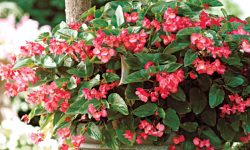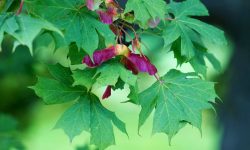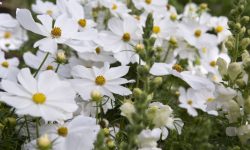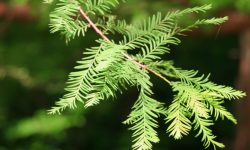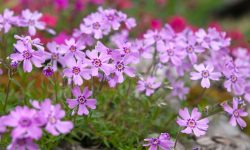The great diversity of palm trees that beautify California’s landscape, each with its own distinct beauty, is abundant. These 28 palm species, which range in size from the state’s largest King Palm to its smallest Dwarf Sugar Palm, highlight the state’s various climates. California is known for its vivid and scenic surroundings, which is enhanced by its palm trees, which include the exotic Dwarf Majesty Palm and the renowned Queen Palm.
Different Types of California Palm Trees
King Palm (Archontophoenix alexandrae)
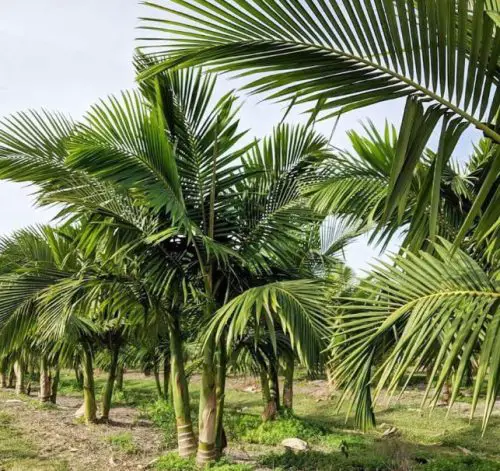
The King Palm, native to Australia, brings an air of elegance to Californian landscapes with its graceful growth. A landmark in coastal California, it stands tall at an average height of 100 feet and 15 feet wide. Known for its distinctive arching fronds, slim trunk, and graceful upright growth, the King Palm boasts a growth rate of 2-4 feet per year. Thriving in both California and its native Australia, this palm tree is a symbol of sophistication and natural beauty in diverse environments.
Queen Palm (Syagrus romanzoffiana)
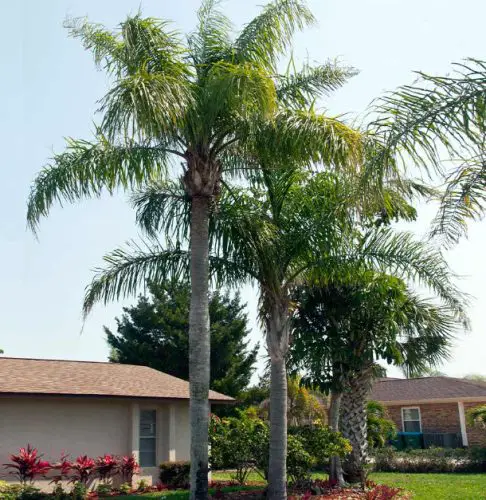
A common sight along California streets and beaches, the Queen Palm is renowned for its smooth trunk and arched fronds adorned with feather-like leaflets. Flourishing in warm climates, it reaches an average height of 50 to 70 feet and a width of 20 to 30 feet, growing at a rate of 2 feet per year. Its distinctive curved fronds, resembling feathers, contribute to its elegant appearance, making it a popular choice for landscapes in various regions.
Kentia Palm (Howea forsteriana)
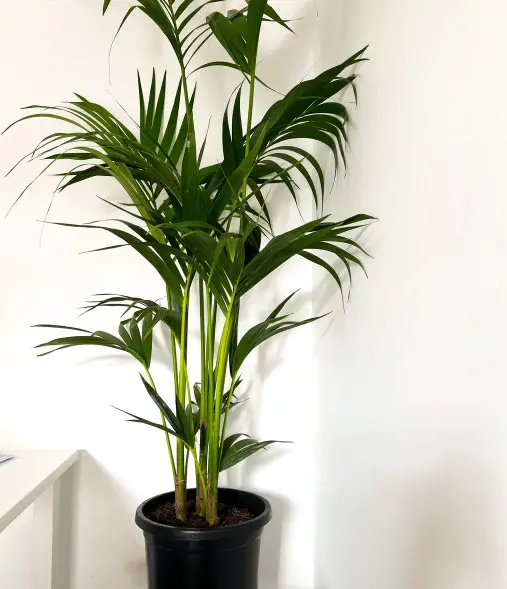
The Kentia Palm, prized for its ornamental beauty, serves as a focal point in lawns and gardens across the Golden State. Flourishing in California, it attains an average height of 20 to 60 feet and a width of 15 feet, with a moderate growth rate of 1.5 feet per year. Recognized by its arching fronds and distinct V-shaped leaflets, the Kentia Palm adds a touch of sophistication to diverse landscapes.
Windmill Palm (Trachycarpus fortunei)
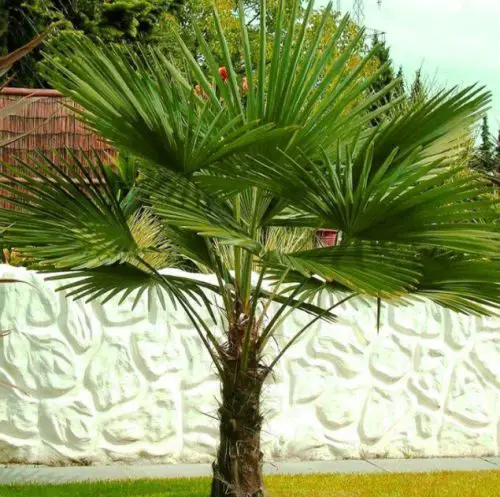
Named for its distinctive frond arrangement resembling a decorative canopy, the Windmill Palm graces California landscapes with its unique charm. Thriving in the state, it reaches an average height of 10-40 feet and a width of 10 feet, boasting a gradual growth rate of 1 foot per year. The bunched grouping of its fronds sets the Windmill Palm apart as an eye-catching and ornamental addition to various outdoor spaces.
Date Palm (Phoenix dactylifera)
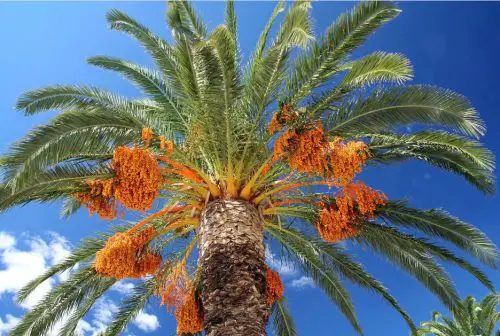
Primarily cultivated for its abundant harvest of delectable and succulent dates, the Date Palm also adds ornamental beauty to its surroundings. Flourishing in the coastal areas of California, it attains an average height of 50 to 80 feet and a width of 20 to 40 feet, with a steady growth rate of 1-2 feet per year. Distinguished by its large clusters of fruits and gracefully arching fronds, the Date Palm stands as a symbol of both utility and aesthetic appeal in the Californian landscape.
Pygmy Date Palm (Phoenix roebelenii)
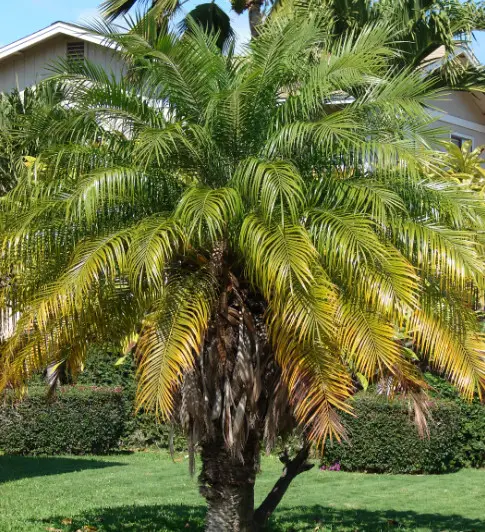
Compact and versatile, the Pygmy Date Palm finds a perfect fit in small corners of yards or containers. Native to southeastern Asia and hardy in Zones 10 and 9b, it achieves an average size of 6.5 feet in height and 5 feet in width. Growing at a rate of 10 inches per year, its distinguishing features include a compact size, thick trunk, and lush green fronds, making it an ideal choice for those seeking a petite yet charming addition to their landscape.
Mexican Fan Palm (Washingtonia robusta)
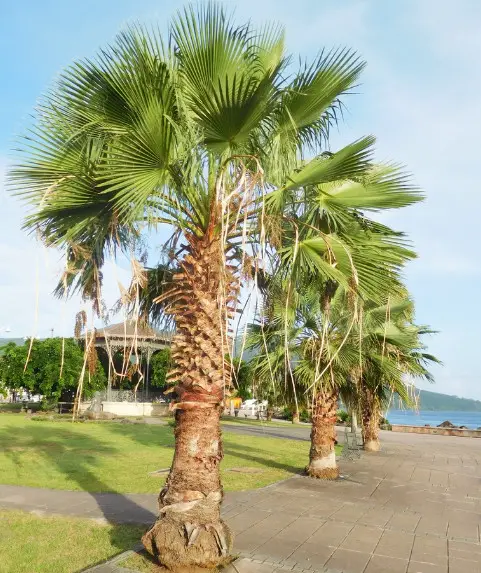
Renowned for its distinctive skirt-like growth atop the trunk and a gracefully round crown, the Mexican Fan Palm stands out in popularity. Thriving in Zone 9a, it attains an average height of 40 to 80 feet and a width of 8 to 10 feet, growing at a rate of 2 feet per year. Its unique characteristics, including the round crown, skirt-like growth beneath it, and a slim trunk, make the Mexican Fan Palm an iconic and sought-after choice for landscapes.
European Fan Palm (Chamaerops humilis)
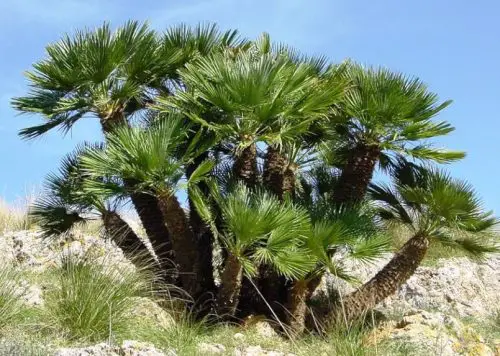
Hailing from the Mediterranean, the European Fan Palm has seamlessly adapted to California’s climate and soil. Flourishing throughout California, it reaches an average height of 6 to 15 feet and spans 15 feet in width. Growing at a rate of 10 inches per year, its distinguishing features include multiple trunks, fan-shaped leaves, and charming yellow flowers, making it a delightful addition to the diverse landscapes of the Golden State.
Triangle Palm (Dypsis decaryi)
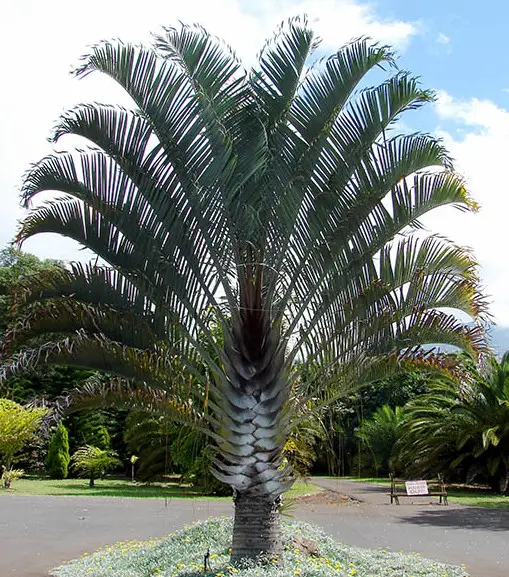
Distinguished by its unique flat canopy emerging from a short trunk, the Triangle Palm offers a distinctive look ideal for compact California spaces. Thriving in both California and the Madagascar rainforest, it reaches an average height of 5-30 feet and width of 12-15 feet, with a growth rate of 7 inches per year. Its outstanding features include flat, fan-shaped leaves and short, slender stems, making it an exceptional choice for those looking for a unique palm variety.
Bismarck Palm (Bismarckia nobilis)
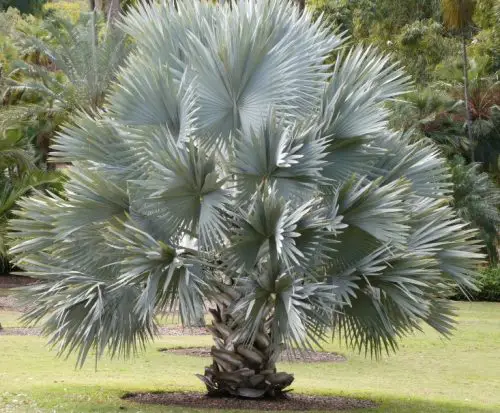
Known for its distinctive appearance, the Bismarck Palm stands out with a thick trunk and gray-silver leaves. Thriving in Southern California, it attains an average height of 40 to 70 feet and a width of 10 to 15 feet. With a slow growth rate of 1 foot per year, this palm takes time to reach maturity. Its distinguishing features, including the robust trunk and fan-shaped silver leaves, make it a remarkable and visually appealing addition to the Southern Californian landscape.
Pindo Palm (Butia capitata)
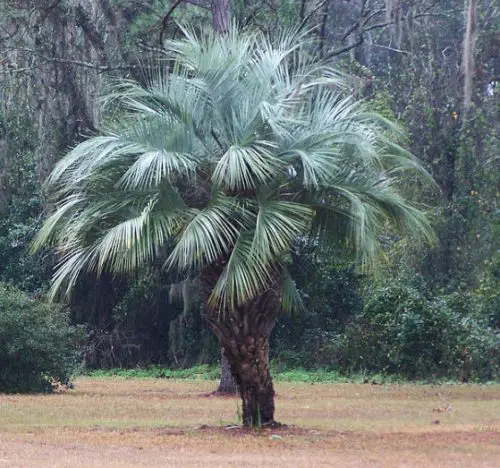
Hailing from Brazil, the Pindo Palm graces the public parks of southern California, earning the affectionate moniker “jelly palm.” Flourishing in warm regions of both California and Brazil, it reaches an average height of 15-20 feet and a width of 15 feet. With a growth rate of 12 inches, its distinguishing features include a robust, upright trunk adorned with arching green fronds, adding to its allure in diverse landscapes.
Sago Palm (Cycas revoluta)
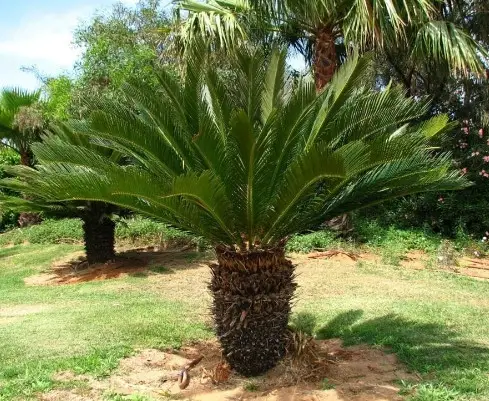
A Japanese native, the Sago Palm is easily cultivated in pots, allowing for a compact size. While native to Japan, it thrives in southeastern California. With an average size of 3 to 8 feet in height and 2 to 12 feet in width, it grows at a rate of 6 inches per year. Distinguished by its short, thick trunk and fan-like green fronds, the Sago Palm brings ornamental charm to both indoor and outdoor settings.
Guadalupe Palm (Brahea edulis)
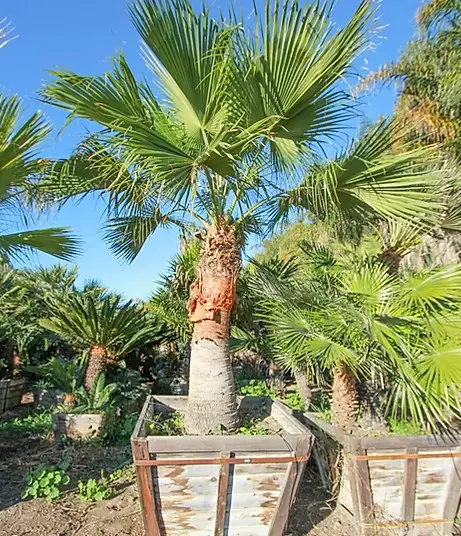
Thriving in Southern California, the Guadalupe Palm boasts bluish-green, fan-shaped fronds forming a low canopy. With a stout trunk bearing scars of fallen dead fronds, it reaches an average size of 30-40 feet in height and 10-15 feet in width. Growing at a rate of 12 inches per year, its distinguishing feature includes fragrant yellow flowers that bloom in the summer, adding a delightful touch to its appeal.
California Fan Palm (Washingtonia filifera)

As the only native palm tree in California, the California Fan Palm showcases fan-shaped fronds with waxy green blades. Flourishing in California and the Western United States, it attains an average height of 40 to 60 feet and a width of 20 feet, growing at a rate of 1.5 feet per year. Its distinguishing feature includes a petticoat of dead leaves under the crown, contributing to its unique visual appeal in diverse landscapes.
Canary Island Date Palm (Phoenix canariensis)
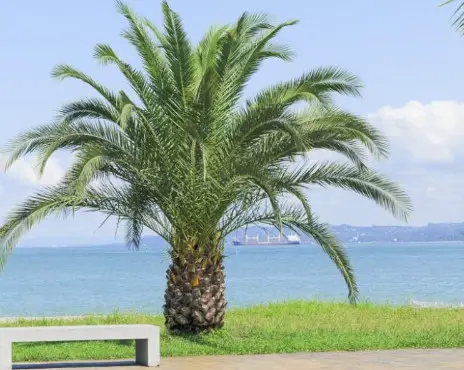
Adorning California streets and beaches, the Canary Island Date Palm is a popular choice with its pineapple-like canopy and graceful silhouette. Thriving across California and even in the UK, it achieves an average height of 40 to 60 feet and a width of 40 feet, growing at a rate of 2 feet per year. Distinguished by diamond patterns and thick growth under the crown, this palm stands out for its distinctive and appealing characteristics.
Parlor Palm (Chamaedorea elegans)
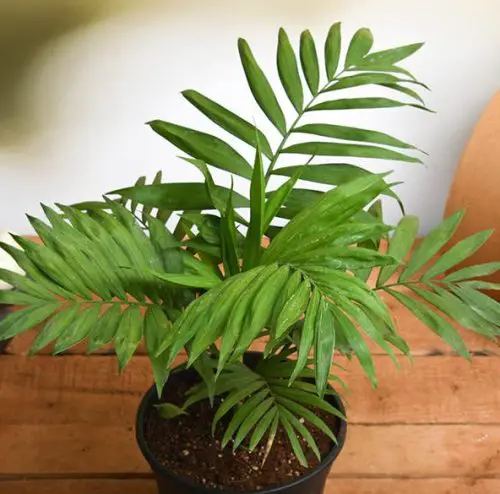
Space-efficient with no trunk, the Parlor Palm’s fronds gracefully emerge from the ground, arching in all directions. Thriving in Southern California, Mexico, and Guatemala, it attains an average height of 6-16 feet and a width of 2-3 feet, growing at a rate of 6 inches per year. Its distinguishing features include the absence of a trunk, allowing it to fit seamlessly into various spaces, and its long, green fronds that emanate from the crown, adding a touch of elegance to indoor and outdoor settings.
Christmas Palm (Adonidia merrillii)
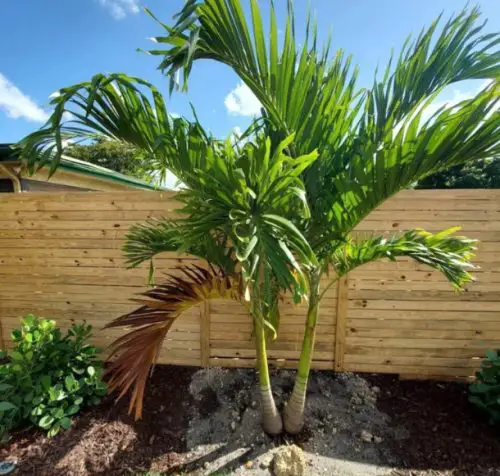
Originating from the Philippines, the Christmas Palm has captured Californians’ hearts with its elegant, shapely leaves and abundant clusters of red fruits. Flourishing in both California and its native Philippines, it attains an average height of 20 to 25 feet and a width of 15 feet, growing at a rate of 2 feet per year. Distinguished by its arching pinnate leaves and striking red fruit clusters, the Christmas Palm stands out as a festive and cherished addition to Californian landscapes.
Spindle Palm (Hyophorbe verschaffeltii)
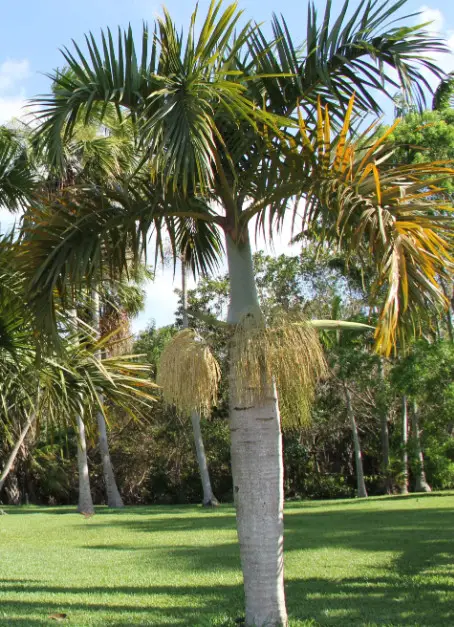
Boasting a smooth and slender trunk with decorative green fronds, the Spindle Palm adds an aesthetic touch to Californian landscapes. Flourishing in both California and its native Mauritius, it reaches an average height of 18 feet and a width of 10 feet. Growing at a rate of 1 foot per year, its distinguishing features include the slender, smooth trunk that tapers towards the end, creating an elegant and visually appealing profile in various outdoor settings.
Cuban Royal Palm (Roystonea regia)
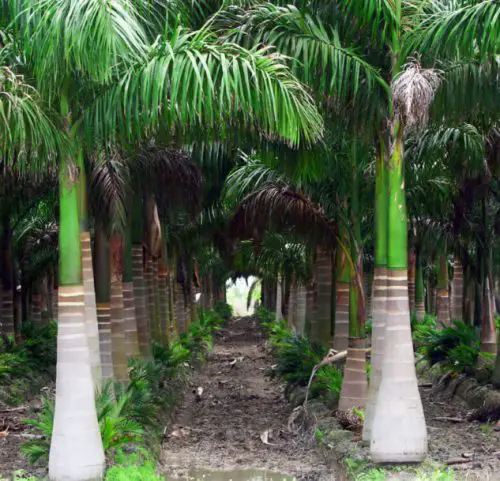
Once gracing royal palaces, the Cuban Royal Palm now embellishes the streets of Havana, Florida, Mexico, and California. Flourishing in diverse climates, it reaches an average height of 50 to over 80 feet and spans 20 feet in width. Growing at a rate of 2 feet per year, its distinguishing features include an ornate slender trunk crowned with lush green fronds, adding regal elegance to the landscapes it inhabits.
San Jose Hesper Palm (Brahea brandegeei)
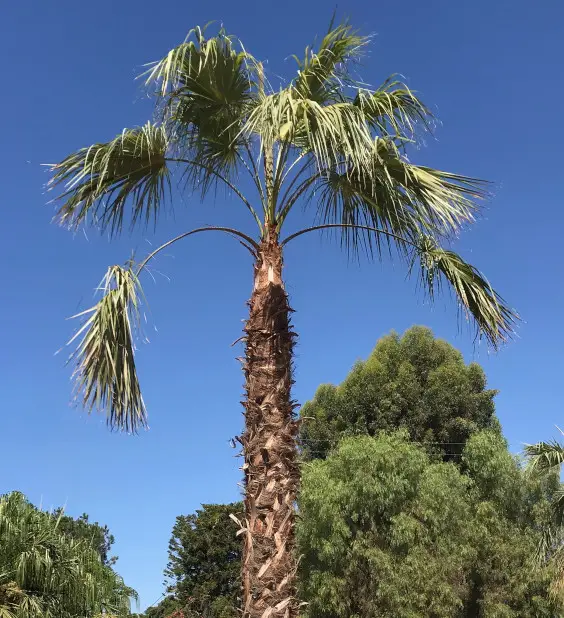
With a rugged charm, the San Jose Hesper Palm may lack the sleek elegance of its counterparts, but its rough edges carry a unique beauty. Flourishing in Baja California, it achieves an average height of 40 to 60 feet and a width of 15 feet. Growing at a measured rate of 1 foot per year, its distinguishing features include a rough trunk complemented by fan-shaped fronds, offering a distinctive and appealing character to landscapes.
Saw Palmetto (Serenoa repens)
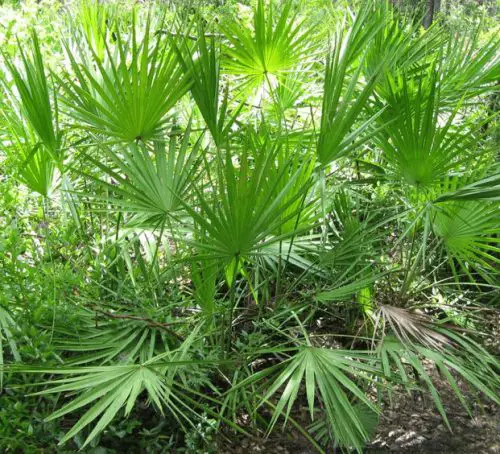
Perfect for indoor cultivation, the Saw Palmetto graces homes as a captivating houseplant. Thriving in South California, Florida, and South Carolina, it attains an average height of 7-10 feet, growing at a steady rate of 5 inches per year. Distinguished by its short, slender trunk adorned with clusters of fronds emerging from the top, the Saw Palmetto adds a touch of stunning beauty to indoor spaces.
Dwarf Palmetto (Sabal minor)
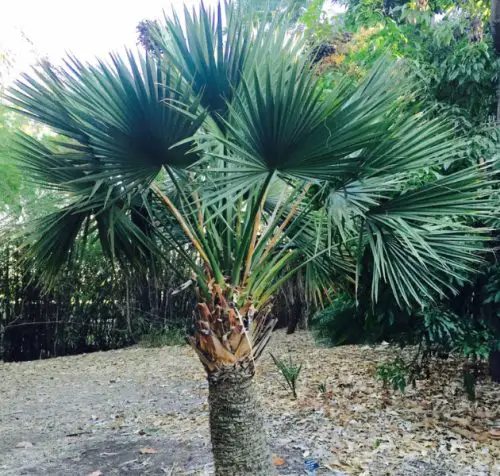
Ideal for indoor cultivation, the Dwarf Palmetto is favored for its compact nature, with bushy fronds that make efficient use of space. Flourishing in California and Mexico, it attains an average height of 2 to 10 feet, growing at a rate of 6 inches per year. Distinguished by its short trunk and vibrant, bushy green fronds, the Dwarf Palmetto stands out as a popular choice for those seeking a manageable and decorative indoor palm.
Dwarf Majesty Palm (Ravenea hildebrandtii)
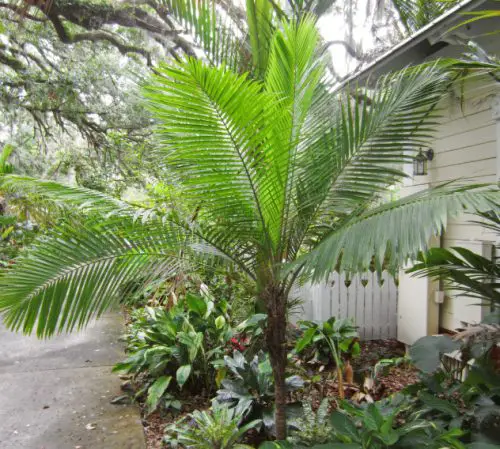
Hailing from the Comoros, the Dwarf Majesty Palm boasts a unique appearance with a bloated trunk that tapers at the top and gains girth towards the ground. Reaching an average size of 7 feet in height and 12 feet in width, it grows at a rate of 7 inches per year. Distinguished by its distinctive trunk and fan-like dark-green fronds, the Dwarf Majesty Palm adds a touch of exotic elegance to diverse landscapes.
Dwarf Sugar Palm (Arenga engleri)
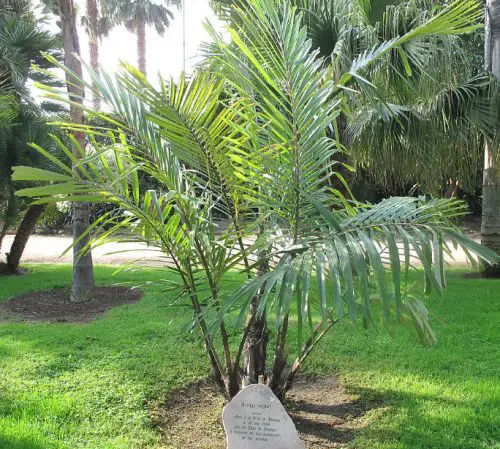
With no trunk, the Dwarf Sugar Palm showcases feather-like leaves emerging directly from the ground. Flourishing in Southwestern California, it attains an average size of 8 feet in height and up to 16 feet in width, growing steadily at 6 inches per year. Distinguished by its trunkless form, feather-like leaves, and charming orange flowers, the Dwarf Sugar Palm adds a distinctive touch to landscapes.
Mule Palm (X Butiagrus nabonnandii)
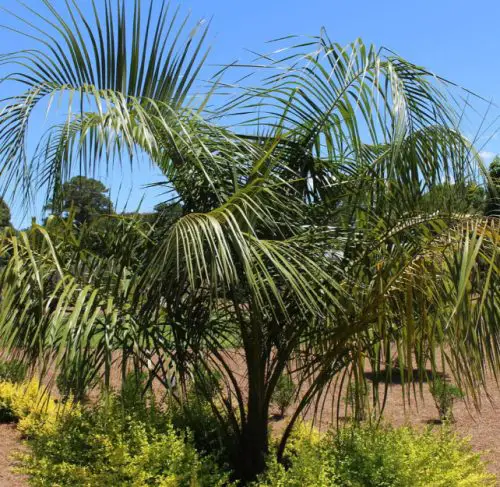
A sterile hybrid, the Mule Palm earns its name from its inability to produce seeds. Thriving in Southern California, it reaches an average size of 15 to 30 feet in height and 6 to 8 feet in width. Growing at a rate of 7 inches per year, its distinguishing features include a slender and upright trunk adorned with fan-like, thick fronds. The Mule Palm stands out for its unique characteristics and adaptability in diverse landscapes.
People Who Read This Also Read:


